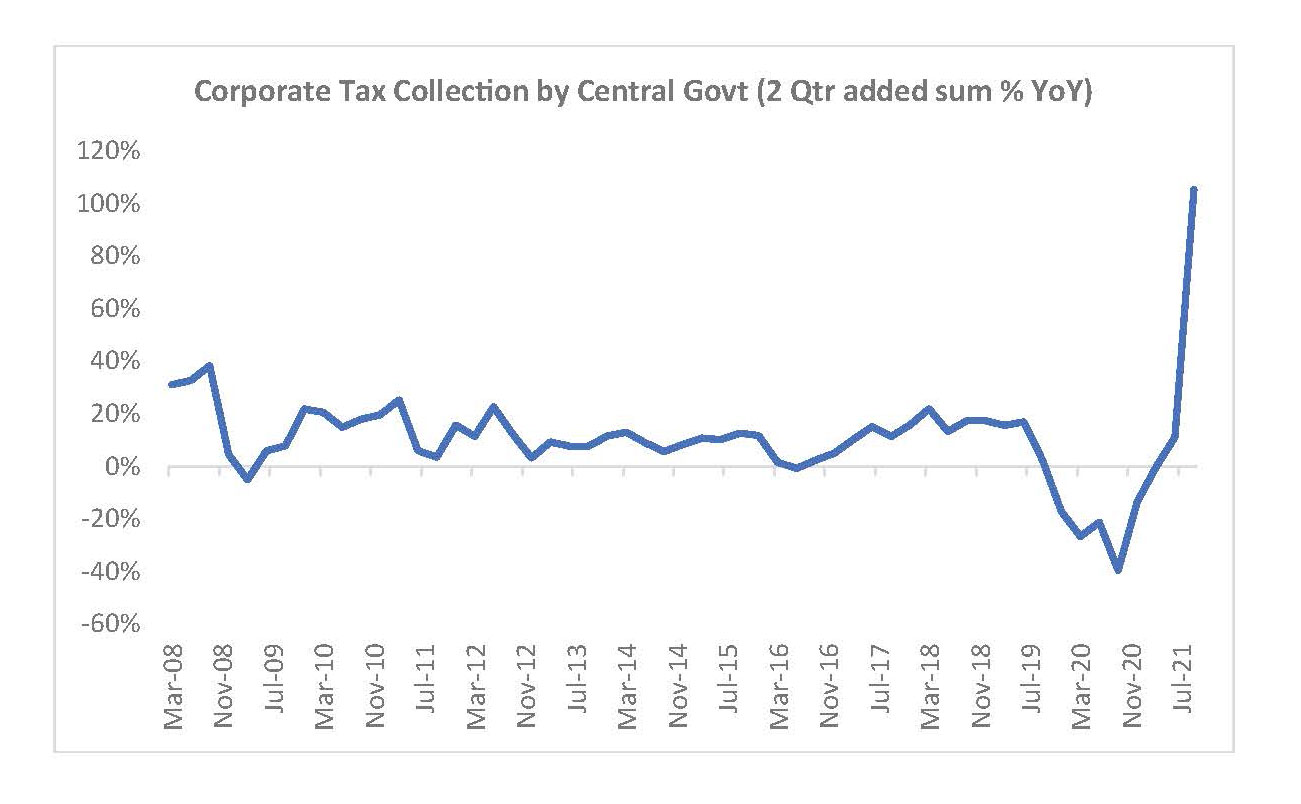
Macro and
Equity Market
Outlook
Equity Market
Outlook
Global Macro & Markets
Global Markets rebounded in October with US S&P500
hitting its all-time high as more than 80% of the
companies reporting results surprised the street
positively on the quarterly earnings. MSCI World gained
5.6% MoM on the back of S&P500 (+6.9%) and Euro50
(+5%). MSCI EM lagged the rally at 0.9% gains as Brazil
was down 6.7% while NIFTY50 India and MOEX Russia
remained muted at 0.3% and 1.1% gains respectively.
Brent Crude crossed the $80/bbl mark to gain 7.5% over
the month. LME Metals index also gained 5.6% MoM
despite some weakness in the latter half of the month.
Domestic Macro & Markets
SENSEX hit new all-time highs in middle of the month but ended almost
flat amid concerns over steep valuations, rising commodity prices and
mixed earnings. BSE MidCap index (+0.1%) and BSE SmallCap index (-0.4%)
ended almost in-line with SENSEX (0.3%). Among sector indices,
Discretionary (+6%), Financials (+3%) and Energy (0%) outperformed the
index while Staples (-5.8%), HealthCare (-4.1%) and IT (-2.5%) lost the most.
Market breadth declined in September with 81% of BSE 100 stocks
remained above their respective 200-day moving averages. FPIs sold
US$2.2bn of Indian equities while DIIs bought US$0.6bn.

India's high frequency data update:
With current account in surplus, GST collections at all time highs,
manufacturing activity expanding rapidly and inflation moderating, macro
data has been quite encouraging over the month.
Manufacturing PMI:
Manufacturing PMI rose to an 8-month high of 55.9 in October compared
to 53.7 in September. New orders continued to expand in October amidst
low inventory levels.
GST Collection:
Collections in October 2021 clocked second highest collections of over
INR
1.3 Tn (+24% YoY) as compared to INR 1.17 Tn in September.
Power consumption:
Power consumption in the month of October was 6.6% higher than
October-20 and 19.5% higher than the consumption in October-2019.
Core sector production:
Core sector production rose 4.4% in September as against a YoY rise of
11.5% in August and rise of 0.6% in September last year.
Industrial Production:
Manufacturing IIP rose 9.7% YoY in August vs a fall of 7.6% in August
of last
year.
Credit growth:
Credit growth remained sluggish at 6.5% YoY as of 8-October against YoY
growth of 5.7% as observed on 9-October 2020. Aggregate deposit
growth picked up to 10.5% YoY.
Inflation:
CPI inflation in September fell sharply to 4.35% yoy amid favourable
base
and softening food prices. WPI inflation came at 10.7% yoy in September
moderating from 11.4% in August.
Trade Deficit:
September trade deficit increased sharply to US$22.9 bn as compared to
US$13.9 bn in August. Non-oil exports increased 18.7% to US$28.5 bn over
September 2020 while non-oil imports increased 57.8% YoY to US$39 bn.
Current Account Balance:
The current account registered a surplus in 1QFY22, rising to $6.5 bn
(0.9%
of GDP) against a deficit of US$8.2 bn in 4QFY21 (-1% of GDP) and surplus
of US$19.1 bn (3.7% of GDP) in 1QFY21. The surplus was led by moderation
in trade deficit to US$30.7 bn (4QFY21: US$41.7 bn) and an increase in net
services receipts to US$25.8 bn (US$23.5 bn in 4QFY21).
GatiShakti initiative
The Union cabinet approved the INR 100 Cr PM GatiShakti National Master
Plan for multi-modal connectivity to develop infrastructure and reduce the
logistics cost to boost the economy.
Reappointment of the RBI Governor
The Government has reappointed Mr Shaktikanta Das as Reserve Bank of
India’s Governor for 3 more years. As the RBI starts to unwind its loose
monetary policy, stability in its top leadership has been critical and
reappointment of Das is being considered as a welcome development.
Market View
Indian equity market sentiment has remained resilient despite the
record
high valuations supported by higher liquidity, strong earnings possibility,
relatively lower rates. The improving domestic macro data suggests that a
reasonable economic recovery is underway. Capex revival, business
normalization, improving global trade and domestic consumption are key
contributors to this anticipated recovery.
Higher inflation may pose a potential challenge for prevailing easy
liquidity
& lower rates and any faster than expected normalization in the same may
impact market sentiment. Geo-political developments and oil prices are
other key areas to be tracked.
We believe all three market cap segments (Large, Mid and Small) offer
similar risk reward, making a case for diversified strategies with investments
across market caps. Conservative investors seeking equity exposure with
lower volatility may consider asset allocation strategies like Multi
Asset/Balanced Advantage etc.
Note: The sectors mentioned are not a recommendation to buy/sell in the
said sectors.
The schemes may or may not have future position in the said
sectors. For complete details on Holdings & Sectors of NIMF schemes, please visit
website mf.nipponindiaim.com;
Past performance may or may not be sustained in future
Past performance may or may not be sustained in future
Chart of the month :
Central Govt tax collections have been very strong in 1HFY22. Within
that,
partly aided by favourable base, corporate tax collections grew massive
105% YoY in the 1H. This amounts to 56% of the budgeted target.

Common Source:
CMIE, Nippon India Mutual Fund Research, Bloomberg
Disclaimer: The information herein above is meant only for general
reading purposes and the views being expressed only constitute
opinions and therefore cannot be considered as guidelines, recommendations or as a
professional guide for the readers. The document
has been prepared on the basis of publicly available information, internally developed
data and other sources believed to be reliable. The
sponsor, the Investment Manager, the Trustee or any of their directors, employees,
associates or representatives (“entities & their
associates”) do not assume any responsibility for, or warrant the accuracy,
completeness, adequacy and reliability of such information.
Recipients of this information are advised to rely on their own analysis,
interpretations & investigations. Readers are also advised to seek
independent professional advice in order to arrive at an informed investment decision.
Entities & their associates including persons
involved in the preparation or issuance of this material shall not be liable in any way
for any direct, indirect, special, incidental,
consequential, punitive or exemplary damages, including on account of lost profits
arising from the information contained in this
material. Recipient alone shall be fully responsible for any decision taken on the basis
of this document.
